Abstract
Radiation survival curves are presented for several normal parenchymal cell types irradiated in situ or in vitro. The data presented indicate that the in situ survival parameters for a specific cell type cannot be simply extrapolated from the results of either in vitro assays or rapid in vivo clonal transplantation assays. The data suggest that the D0 and terminal slope of in vitro survival curves can reflect those parameters for cells left in situ, but the shoulder width and the n value cannot. This appears to be due to the inability of the in vitro environment to support two major forms of repair that occur in situ, i.e. the "contact effect" and in situ repair (ISR). ISR is a form of potentially lethal damage repair (PLDR) that occurs when certain cells are allowed to remain in situ following irradiation. ISR is characterized by an increased shoulder in the survival curve without a change in slope and it has been observed in rat mammary, thyroid and liver epithelia.
Full text
PDF




Selected References
These references are in PubMed. This may not be the complete list of references from this article.
- Clifton K. H., DeMott R. K., Mulcahy R. T., Gould M. N. Thyroid gland formation from inocula of monodispersed cells: early results on quantitation, function, neoplasia and radiation effects. Int J Radiat Oncol Biol Phys. 1978 Nov-Dec;4(11-12):987–990. doi: 10.1016/0360-3016(78)90010-x. [DOI] [PubMed] [Google Scholar]
- Durand R. E., Sutherland R. M. Effects of intercellular contact on repair of radiation damage. Exp Cell Res. 1972 Mar;71(1):75–80. doi: 10.1016/0014-4827(72)90265-0. [DOI] [PubMed] [Google Scholar]
- Gould M. N., Biel W. F., Clifton K. H. Morphological and quantitative studies of gland formation from inocula of monodispersed rat mammary cells. Exp Cell Res. 1977 Jul;107(2):405–416. doi: 10.1016/0014-4827(77)90362-7. [DOI] [PubMed] [Google Scholar]
- Gould M. N., Clifton K. H. Evidence for a unique in situ component of the repair of radiation damage. Radiat Res. 1979 Jan;77(1):149–155. [PubMed] [Google Scholar]
- Jirtle R. L., McLain J. R., Strom S. C., Michalopoulos G. Repair of radiation damage in noncycling parenchymal hepatocytes. Br J Radiol. 1982 Nov;55(659):847–851. doi: 10.1259/0007-1285-55-659-847. [DOI] [PubMed] [Google Scholar]
- Mahler P. A., Gould M. N., DeLuca P. M., Jr, Pearson D. W., Clifton K. H. Rat mammary cell survival following irradiation with 14.3-MeV neurons. Radiat Res. 1982 Aug;91(2):235–242. [PubMed] [Google Scholar]
- Mulcahy R. T., Gould M. N., Clifton K. H. The survival of thyroid cells: in vivo irradiation and in situ repair. Radiat Res. 1980 Dec;84(3):523–528. [PubMed] [Google Scholar]


